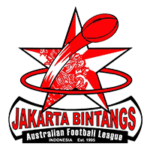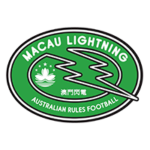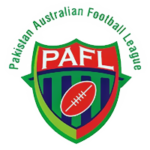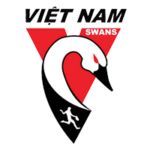As we countdown the final days of 2019, AFL Asia has taken an opportunity to reflect on the biggest achievements over the past decade throughout the region. Whilst the exact order of the top 10 may be debated, no one can dismiss that its been an outstanding decade for those involved in the AFL Asia wider community. Here are our top 10 achievements of the decade!
#10 6 Different Asian Champs Winners in 6 Years
In what may be a first in any football tournament and/or competition throughout the world, there has been six different Division 1 Asian Championships winners over the past 6 years!
The Singapore Wombats (2014), Hong Kong Dragons (2015), Philippine Eagles (2016), Malaysian Warriors (2017), Indonesian Volcanoes (2018) and the PNG Muruks (2019) have all had their day in the sun and basked in the glory of being the Champions of Asia.
The astonishing statistic highlights the closeness of the teams and that any team is capable of winning AFL Asia’s showcase event on any given day.

Can someone please check the history books! Has there ever been another footy league, association, competition or tournament across the globe that has had 6 different winners in 6 years?!
#9 Growth of Clubs
As mentioned in number 7 there has been 9 new Women’s football teams that have been established over the past few seasons, which is an outstanding achievement.
A number of clubs have fielded two teams at varying stages at an Asian Champs level since the Division 2 and 3 were introduced and they include the following teams; Hong Kong Dragons, Indonesian Volcanoes, Japan Goannas & Warriors, Malaysian Warriors, Singapore Wombats and the Vietnam Swans.
The pure depth and amount of players that exist within each club/league has been fantastic to witness and we hope that it’s a trend that can be continued long into the future, whether that be at an Asian Champs level or at Masters Tournaments within the region.
The Himalayan Leopards (Associate Member since 2018) and the Mongolian Wolves (Associate Member since 2019) are the most recent clubs that have been established. It has been enjoyable following their progress over their journey and expect both to take another step forward in their development in 2020.
Although not new to starting their football journeys as countries, AFL Asia has also been able to develop key working relationships with AFL Japan (Full Member since 2017), Australian Football Sri Lanka (Associate Member since 2018), Reclink India (Associate Member since 2018), along with AFL India, AFL Pakistan and AFL Timor Leste and in doing so, has added further developmental value to the region.
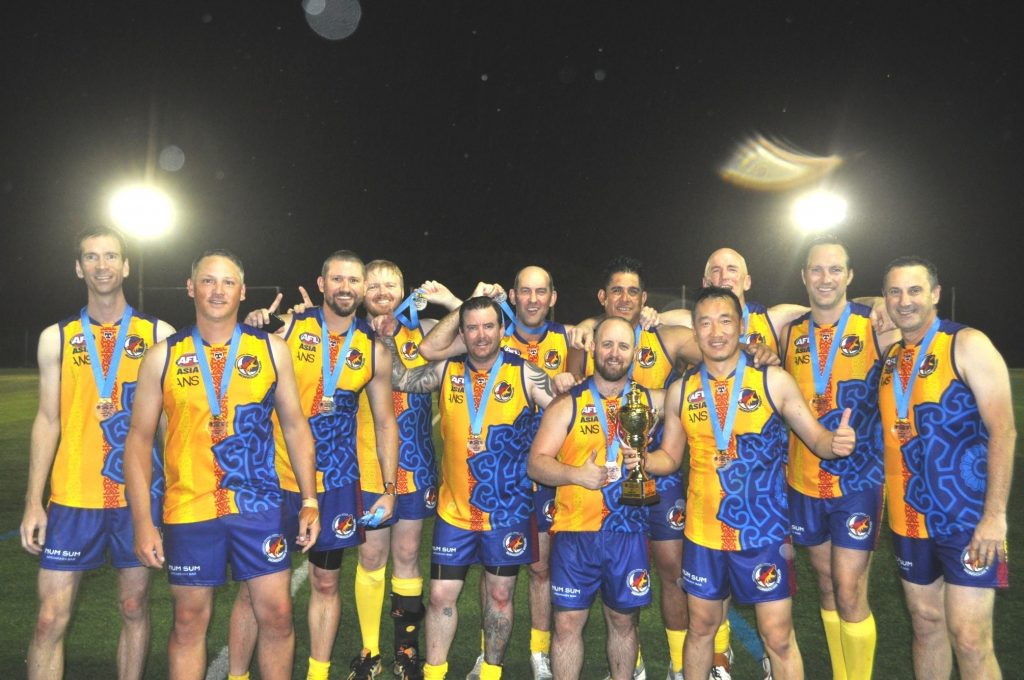
The Mongolian AFL and their representative team – The Mongolian Wolves have taken huge strides forward since they were established earlier in the year. We look forward to seeing whats in store for them in 2020, with the AFL Asia Shanghai Cup and Asian Champs firmly in their sights.
#8 3 x Men’s Divisions at Asian Champs
3 Men’s Divisions were first introduced at the AFL Asia 2019 Asian Championships in Thailand, after there had been quite a notable difference between the standard of higher performing teams in the existing Division 2 and those teams that had been struggling to compete with them for a number of years.
As a result, on a case by case basis analysis AFL Asia essentially allocated the previous 10 teams from Division 2 in 2018 as well as 2 Japan-based teams into Division 2 and the newly created Division 3, which effectively included 6 teams in each division.
The results were much closer in the new Division 2 & 3 formats than in previous years and gave an opportunity for perennial strugglers to succeed.
We shouldn’t forget that the Division 2 was only introduced for the first time at the AFL Asia 2015 Asian Championships held in Bangkok, Thailand, with the Laos Elephants taking out the inaugural Division 2 tournament, whilst the Bali Geckos achieved the ultimate Division 2 glory in 2016 & 2017 in the proceeding years.
The PNG Muruks played a Harlem Globetrotters style of football and went undefeated in 2018, while the Vietnam Swans achieved their well-deserved maiden breakthrough triumph whilst taking out the 2019 Division 2.
The inaugural Division 3 was a tightly contested division with only percentage separating the top 4 teams after the preliminary games were completed. The Japan Goannas went onto become the first-ever Division 3 Champions after defeating the Macau Lightning in a nail biter grand finale by a solitary point.

The Laos Elephants were the first team to hoist the Asian Champs Division 2 trophy back in 2015 before the Bali Geckos dominated for 2 years. Whilst the Japan Goannas put a three year Asian Champs hiatus to the side and claimed the first-ever Asian Champs Division 3 title in 2019.
#7 The Growth of Women’s Football
The AFLW national competition was first launched in 2017 after being in the pipeline for a number of years. The exponential growth that the AFLW competition has directly created has been astonishing and has certainly made an impact within our region.
The first exhibition game was played at the 2016 Asian Champs in Vietnam, which saw a large contingent of female players become the pioneers and lay the foundations of what we have seen achieved today.
The growth and establishment of teams has been sensational since that initial exhibition game, with the Cambodian Apasaras, and the Malaysian Warrior Women’s spawned into fruition as teams in 2017, whilst the Hong Kong Dragons, Japan Mirais and the Vietnam Lady Swans followed in 2018.
As a result, the inaugural AFLW Asian Championships was first played in Kuala Lumpur, Malaysia in 2018, with the Vietnam Lady Swans becoming the first ever Champions of Women’s Football in Asia after defeating the Hong Kong Dragons in a Grand Final that took the Asian Championships by storm.
Women’s football has grown like wildfire in 2019 with additional teams being established, including; the Bali Pink Geckos, Jakarta Bintangs, Singapore Wombettes and the Thailand Tigers.
The second edition of the AFLW Asian Championships in Thailand saw the tournament grow from 4 teams in the inaugural year to 6 teams in 2019, with the host nation – The Thailand Tigers and the Singapore Wombettes being added to the fold.
We can expect another increase in the number of participating teams at the 2020 AFLW Asian Championships as well, which is very pleasing from a growth focused perspective.

The growth of women’s football has been super impressive since the first ever Exhibition Game was played at the 2016 Asian Champs. The Vietnam Swans were triumphant in securing the inaugural AFLW Asian Champs, whilst the Malaysian Warrior Women’s rose to glory in 2019. The AFLW All-Asian (born) Team was also introduced for the first time in 2019.
#6 Local Development
A key component of AFL Asia’s mantra has been our strategic focus towards the growth of local development and strongly believe that it is the key ingredient to create sustainable growth for the future of our great game.
Whilst local development has been a bit of a slog for some clubs within the region, those clubs/leagues that have heavily invested in local development programs and initiatives are reaping the rewards both on and off the field.
The first Asian-born Exhibition Game between East Asia & South East Asia was first played at the 2015 Asian Championships in Angeles City, Philippines, and included 40 local players from China, Cambodia, Laos, Thailand, Indonesia, Philippines and Vietnam.
As a way of promoting local development on a grander scale the Vietnam Swans President & AFL Asia Vice President at the time Grant Keys, introduced the All Asia Cup, which was played the day before the 2016 Asian Championships in Vietnam. China, Indochina and Indonesia participated in the tri-series tournament, which showcased Asia’s finest local talent.
The Asian Champs ‘Local Player Policy’ was first implemented in 2017 and was introduced to ensure that all clubs were providing due diligence towards what an overwhelming number of clubs saw as a major priority moving forward.
It’s fair to say that the ‘Local Player Policy’ received its fair share of criticism initially, but as is the case with circumstances in life, AFL Asia had to endure some short-term pain for the long-term gain and benefits that has been created and achieved.
This was highlighted at the AFL Asia 2019 Asian Championships, whereby the growth of local development cannot be understated as 27% of total participants at the Asian Champs were locals and just as impressive was the fact that 11/30 All Asian Team were local-born players, which was an outstanding result and speaks volumes of those clubs who have invested in their local development programs and initiatives.
As previously mentioned the Curtain Closer Clash between the AFL Asia Lions and the Team China Dragons has filled the All Asia Cup void on the AFL Asia calendar, however a long-term goal of ours is to see the All Asia Cup being reintroduced and could potentially be back on the agenda at 2020 Asian Championships after a 4 year absence.

The days of expats having a kick and a catch in Asia has become a thing of the past, with local development strategies and initiatives now at the forefront of clubs and leagues across Asia.
#5 Participation Growth
A recent AFL Asia website article highlighted a 24% increase in participation in 2019, which indicates the game is growing at a rapid rate on the back of local development initiatives and an increase in female, Auskick and school-based program participants, as well as natural growth across the region.
The growth in participation across the Asian region saw the total amount of participants rise from 11,917 in 2018 to 14,769 in 2019, which highlights the fantastic efforts from key volunteers within clubs and leagues, who drive their programs to create sustainable growth for the future of our great game.
Having said that, lets rewind the clock back seven years to 2012 and compare the participation figures at our disposal. In 2012, the AFL Asia participation statistics reported that only 1,264 participants were actively involved in leagues, competitions and programs.
The comparative figure indicates a staggering 1,068% increase in participation over the past 7 years and is a super impressive statistic that the entire AFL Asia wider community should be extremely proud of!

The growth in participation has been phenomenal since the pre-AFL Asia days in 2012 to what is being achieved throughout the region in 2019!
#4 AFL Matches in Shanghai
The AFL’s desire to grow the game internationally and into the world’s biggest economic market in China has been a significantly important landmark achievement in our backyard.
The annual match in Shanghai for AFL Premiership points has proven to be highly beneficial for the AFL, the Port Adelaide Football Club, associated businesses and government organizations and the financial partnerships and investments they’ve been able to secure in the Chinese market.
Port Adelaide played against the Gold Coast Suns in the inaugural match in 2017, as well as in 2018. The Gold Coast Suns decided against continuing their involvement in the annual fixture, which sees Port Adelaide’s opponent play in Shanghai as a ‘home game’.
St. Kilda have since secured the rights to play in Shanghai with the current contractual arrangement due to expire in 2021. After a poor showing by St. Kilda in their first match in China, expect the 2020 Shanghai game to be much more even contest as a result of St. Kilda’s recruiting haul in the off-season. Port Adelaide on the other hand, are currently undefeated in the thriving metropolis and will be looking to celebrate their 150th anniversary year in style.
The Shanghai Cup has been a wonderful feature of the Shanghai weekend and provides Asian-based senior and junior teams, and Australian teams for that matter, an opportunity to participate in a tournament and watch an AFL game live, which they weren’t able previously to do unless they were back in Australia.
It’s also an opportunity of a lifetime for our local Asian-born players, who have been able to play on the big stage at Jiangwan Stadium, as part of the annual curtain closer clash and has certainly been one of the highlights from an AFL Asia perspective. The Team AFL China Dragons have a 2-1 advantage over the AFL Asia Lions, which has turned into a healthy and respectful rivalry.
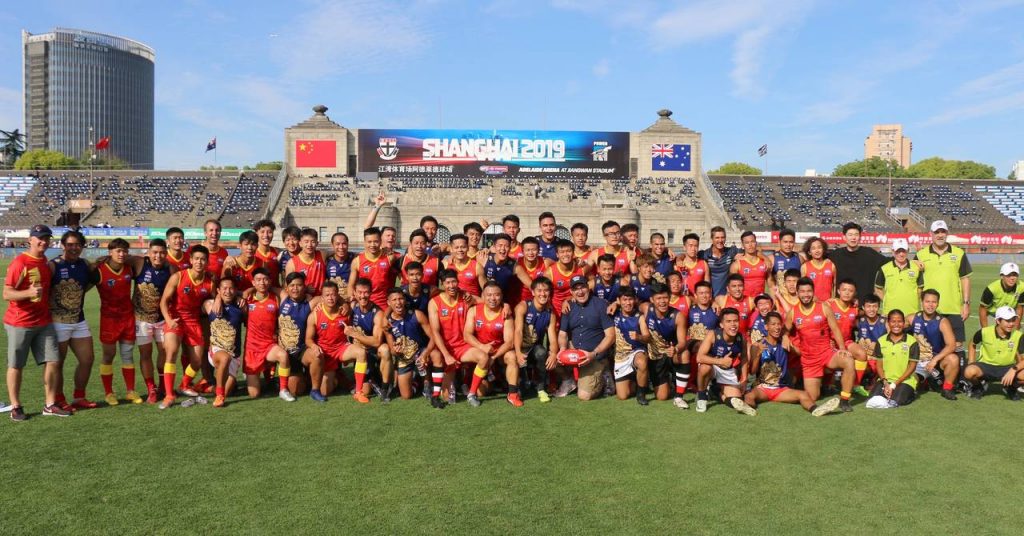
The annual curtain closer clash between the AFL Asia Lions and the Team AFL China Dragons has given the best 50 Asian-born footballers an opportunity of the lifetime and be able to play on the big stage after an AFL match on Jiangwan Stadium in Shanghai, China.
#3 ANS – Foundation Sponsorship
Throughout AFL Asia’s evolving history there’s been a sense of constant growth right across the board, however one key area that had been lacking to further progress the game in a holistic manner was from a financial standpoint.
Enter passionate businessman Tom Lashan and with the support and investment of his company Australian Nutrition and Sports (ANS) based out of Hong Kong, AFL Asia received a significant injection of funding and some much-needed financial security and sustainability that had previously been a missing ingredient.
AFL Asia’s Vice President Darren Whitfield and Treasurer Justin Barbaro at the time secured a 10 year Foundation Sponsorship with Tom & ANS, which was a groundbreaking and monumental moment in AFL Asia’s history and beyond belief back in January 2018.
Since the agreement was established, AFL Asia Full Members have received a portion of the sponsorship arrangement, as a new AFL Asia & ANS collocated logo was introduced and required on all AFL Asia team uniforms.
ANS funding has also been utilized during 2018-19 to subsidize those AFL Asia Full Members, who have enabled their local Asian-born footballers to represent the AFL Asia Lions and play in the annual curtain-closer clash against the Team AFL China Dragons after the completion of Port Adelaide’s Shanghai game on Jiangwan Stadium.
It is expected that a certain percentage of the annual ANS sponsorship funding will be allocated towards an AFL Asia Development Grants Program initiative that the ADM and AAAB are currently in the process of developing, which is exciting news for the region.
It must also be mentioned that Tom has recently been appointed onto the inaugural AFL Asia Advisory Board. We look forward to utilizing his business expertise and assisting us to build AFL Asia’s commercial and corporate partnership portfolio moving forward.
More importantly AFL Asia are incredibly thankful and appreciative of Tom & ANS’s generous financial investment and contributions towards growing the game in the region.

AFL Asia will be eternally grateful for the financial contribution made by successful businessman Tom Lashan and his company ANS.
#2 Appointment of an Asia Development Manager
After years of discussions and consultation with the AFL, the blood, sweat and tears invested by Phil Johns, Darren Whitfield, Grant Keys, Matt Gale (AFL Asia Presidents 2012-19) and their committees of the day finally came to fruition when an agreement was achieved in September 2018, whereby AFL Asia would be able to have its first ever full-time resource.
The investment from the AFL coupled with AFL Asia’s vision to deliver outcomes in unison has since seen Simon Highfield appointed as the Asia Development Manager (ADM) and an AFL Asia Advisory Board (AAAB) been implemented.
The ADM’s role is to manage the day to day operations of AFL Asia, establish and maintain a commercial & corporate partnership portfolio and grow and develop the game more strategically across the region.
Although Simon has only been in his new post for the past 4 months he has made a very impressionable start and is an innovative, well-equipped and supportive leader, and we look forward to what he and the AAAB can achieve moving forward into a new era for AFL Asia.

Simon Highfield was recently appointed as AFL Asia’s first-ever full-time resource on the back of the substantial growth in participation that was achieved during his highly successful tenure with AFL South Pacific.
#1 The Establishment of AFL Asia as an Entity
For years during the 2000’s key club administrators discussed the need to establish a unified and overarching entity that would oversee the clubs existing within Asia.
As fate would have it, AFL Asia was officially formalised on 27 July 2013, when a meeting of Asia’s presidents was held in Bangkok to discuss the future of footy in Asia. In all, 13 countries / clubs physically attended and submissions were received from another four clubs. This was the first time Asian footy leaders had ever met with the sole purpose of preparing a road map for Asian footy (previous meetings were held prior to the Asian Championships when the Asian Champs was the focus).
At this meeting it was quickly agreed that Asian footy needed an umbrella organisation to govern and steer the development of footy in Asia. It was proposed that the organisation be known as AFL Asia – to which the AFL agreed. The AFL also agreed to the AFL Asia logo, which was unveiled at the Asian Champs in Thailand on 17 August 2013.
A key player in achieving the visionary outcome was Phil Johns, who went on to become the inaugural AFL Asia President and laid the platform and foundations for future success.
Phil had previously pulled the necessary strings between the Hanoi Hawks and Saigon Saints to create a national team, the Vietnam Swans, but Asia as a region was a totally different kettle of fish and his efforts to galvanize the new entity were exceptional and considered before his time.
Phil, did a fantastic job as the face of “How good’s Footy in Asia” and we are forever grateful for the legacy achieved on his watch!












